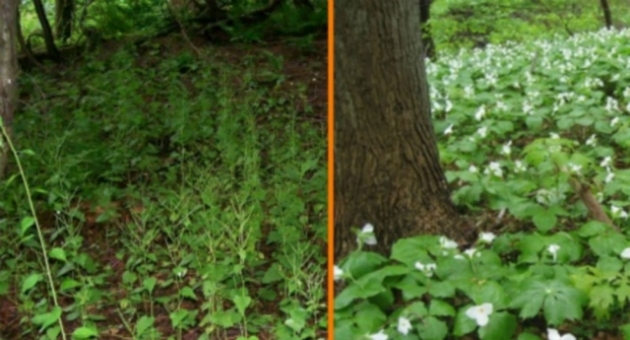Deer populations disrupt plant species

Overabundant deer populations in U.S. forests and wooded areas facilitate the growth of invasive plant species at the expense of native plant species, according to a new study that included Rachel Spigler, assistant professor of biology in the College of Science and Technology at Temple.
The study, “In a long-term experimental demography study, excluding ungulates reversed invader’s explosive population growth rate and restored natives,” was published online in Proceedings of the National Academy of Sciences.
Spigler conducted the study—which was funded by the National Science Foundation—with researchers from the universities of Pittsburgh and Miami.
That phenomenon threatens biodiversity and ecosystem function.
“When you have these deer coming in, they are almost mowing the forest floor of these native species, like trillium, which the deer find tasty,” said Spigler, who joined Temple’s faculty in October. “They reduce the abundance and competitiveness of the native species, so it lowers what we call the ‘biotic resistance’ of the native plant community to resist the invasion of these plants species, like garlic mustard.”
Garlic mustard, an aggressively invading plant species with a rapid two-year life cycle, used to be restricted to roadsides or forest perimeters. Now, it is finding its way into the forest’s interior because of disturbances created by the overabundant deer, Spigler explained.
“We know that a lot of invasive species do well in disturbed habitats,” she said. “Once a species like garlic mustard establishes itself, it can kill off some of the other native species.”
Spigler, whose research focuses on the evolutionary ecology of plant reproduction, added that healthy ecosystems in the hardwood forest of the northeastern U.S. depend on long-living, perennial species of plants like trillium that are slow-growing, as opposed to invasive species.
For their study, Spigler and her colleagues established multiple 196-square-meter plots in the forest, with half being fenced in to exclude deer. They painstakingly studied the fates of the garlic mustard, as well as trillium and other native species.
“We essentially followed every stage of the plant’s life cycle, from seed to adulthood, for six years,” Spigler explained. “So we have a long-term study where we know the fate of each individual stem.”
The researchers found that when deer are excluded from the area, native species begin to recover. “That’s quite expected, since they’re not being eaten by the deer and they’re successfully able to reproduce,” she said.
But in the presence of deer, garlic mustard—which has explosive growth rates of about 30 percent per year—actually declined and was predicted to become extinct when deer were excluded from the area.
“It suggests that overabundant deer are changing plant species interactions fundamentally, and that by curbing the deer populations, we might be able to curb the success of invasive species.”